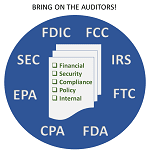It’s difficult to claim that you are compliant with internal or external rules and regulations if you don’t have a good base to start with. Take the concept of the accurate value of your customer contracts for instance or exposure due to vendor contracts, both part of any Sarbanes Oxley regulations (SOX). It’s hard to imagine having complete confidence in those values or exposures, defined as no more than 5% deviation by SOX, if you don’t have confidence in the collection of supporting documentation.
The focus on customer contracts should take precedence and probably does already in terms of recording the contract terms in your billing system. But the effort for the most part is still a manual…














